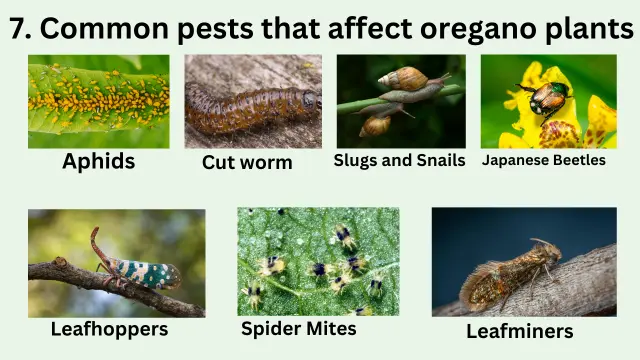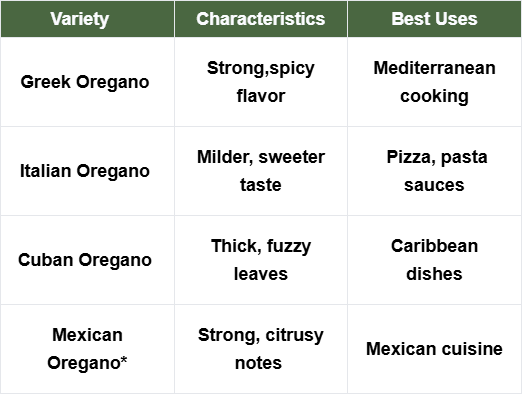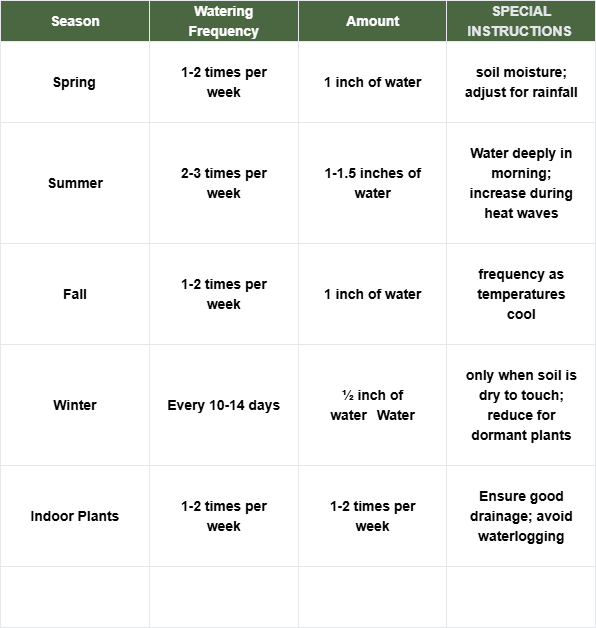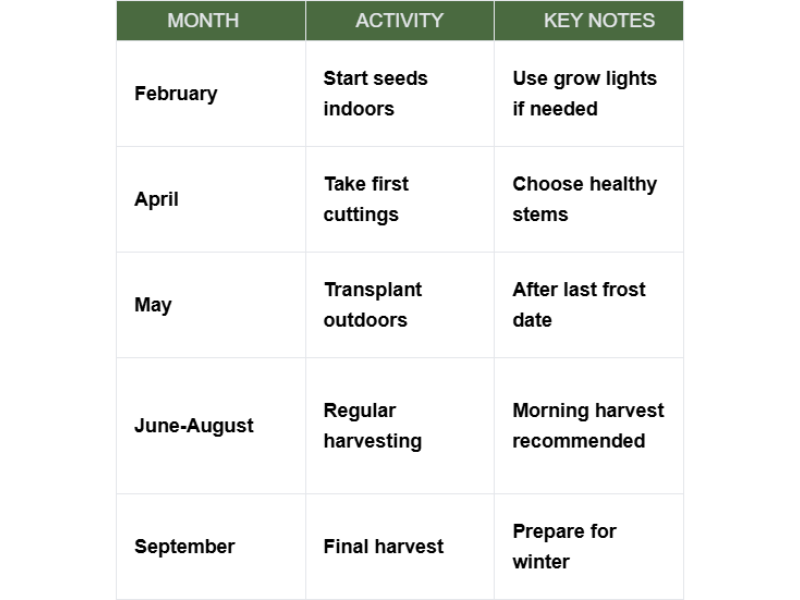How to Grow Oregano at Home
Introduction
Imagine stepping into your kitchen and snipping fresh, aromatic oregano leaves for your favorite Italian dish. Growing oregano at home isn’t just possible – it’s surprisingly simple! Whether you’re a seasoned gardener or just starting your herb garden journey, this guide will walk you through everything you need to know about cultivating this versatile Mediterranean herb.
Oregano (Origanum vulgare) has been cherished for centuries, not only for its robust flavor but also for its medicinal properties. As a perennial herb in the mint family (Lamiaceae), it’s one of the most rewarding plants you can grow, offering years of harvests with proper care.
Key Takeaway
- Oregano thrives in specific soil conditions – it needs well-draining soil with a pH between 6.0 and 7.0, and actually produces more flavorful leaves in less fertile soil. early spring and mid-season.
- The best time to harvest oregano is in the morning after the dew has dried, before the plant flowers, and only once the stems are at least 6 inches tall (typically about 6 weeks after planting). Harvesting at these times ensures the best flavor and plant health.
- Prevention is key for pest control – maintaining plant health through proper growing conditions (6-8 hours of sunlight, good airflow), regular inspection, and cleanliness of gardening tools can prevent most pest problems.
How to Grow Oregano at Home: Getting Started
Choosing Your Growing Method.
You can start growing oregano through several methods:
- From Seeds
- From Cuttings
- From Transplants
- From Seeds
Sow oregano seeds indoors 6-8 weeks before last frost
Maintain soil temperature at 70°F (21°C)
Expect germination in 7-14 day - From Cuttings
Take 4-6 inch stems
Remove lower leaves
Place in water or moist soil
Roots develop in 2-3 weeks - From Transplants
Choose healthy young plants
Look for robust scent and strong stems
Avoid flowering specimens
Soil Calculator for Container Growing oregano
Container Soil Calculator
Soil and Planting Requirements
Oregano thrives in well-draining soil with a slightly alkaline to neutral pH, ideally between 6.0 and 7.0.
Sandy loam or loamy soil is suitable, as it allows water to move through easily while retaining enough moisture. When growing oregano, make sure the soil has a pH between 6.5
For container gardening, use a high-quality potting mix that provides good drainage and is enriched with organic matter.
You can also create a homemade soil mix by combining equal parts of sandy loam and compost, then adding perlite or vermiculite for aeration and a bit of dolomitic lime to balance the
Oregano thrives in well-draining soil with these characteristics:
pH level: 6.0-7.0
Texture: Light and sandy
Organic matter: Moderate
Drainage: Excellent
Mix your potting soil using:
60% high-quality potting soil
20% perlite or coarse sand
20% organic compost
How can I test the pH of my soil for oregano
Oregano thrives in well-drained soil with a pH between 6.0 and 8.0. Here’s how to test your soil pH:
DIY Testing Kits:
- Collect a soil sample from your garden. Ensure the sample is collected from where the plant roots will grow, typically about 6 to 8 inches deep. Remove any roots, grass, or mulch from the sample
- Mix the soil sample with distilled water as per the kit instructions.
- Add the testing solution and compare the color change to the provided scale.
Slurry Test:
- Mix one part soil with one or 1.5 parts distilled water in a container.
- Mix or shake the mixture and let it settle for about 15 minutes.
- Use a pH pen/meter or pH strip to get a reading, which will give you an approximate pH of the soil.
Soil pH Meter:
- Moisten the soil with water before testing.
- Insert the meter into the soil and leave it for the time recommended by the manufacturer.
- Check the reading on the meter for a fairly accurate pH level.
Professional Soil Testing Services:
Send soil samples to a professional testing service or your local county extension office for a more accurate reading. These services will provide a detailed report of your soil’s pH level and mineral and nutrient levels.
Home test kits may not be as accurate as professional lab services for detailed nutrient analysis
How to adjust the soil pH if it's too high or too low for oregano
To adjust your soil pH for growing oregano, here’s what you can do based on whether the pH is too high (alkaline) or too low (acidic):
If the Soil pH Is Too High (Alkaline):
- Add Sulfur: Incorporate sulfur into the soil. Soil microbes will break the sulfur down into sulfuric acid, which lowers the pH over time.A general guideline is to add 1 to 2 pounds of sulfur per 100 square feet, but this may vary based on your soil’s current pH.
- Acidify Irrigation Water: Adjust the pH of your irrigation water, especially if you have alkaline water. This is particularly useful in high tunnels where rainwater doesn’t naturally wash out soluble salts5.
- Incorporate Peat Moss: Mix peat moss into the soil to help lower the pH.
If the Soil pH Is Too Low (Acidic):
- Add Lime: Incorporate lime into the soil. Use dolomitic or calcitic lime, and follow the application rates recommended by a soil test. Generally, 1 to 2 tons per acre is a good starting point, but always check your soil’s needs first.
General Tips:
- Test Regularly: Monitor your soil pH every 6 to 12 months after making adjustments to ensure it remains in the optimal range for oregano1.
- Gradual Adjustments: Make pH adjustments gradually.
- Professional Testing: Consider using professional soil testing services for more precise results, especially if you suspect significant nutrient imbalances.
- Organic Practices: Combine pH adjustments with organic gardening practices like using compost, mulches, and organic fertilizers.
How to lower your soil pH
Here’s a general guideline based on soil texture, measured in pounds of sulfur per acre to a depth of 6 inches
For individual plants, one source suggests assuming each plant requires 4 square feet of acidification and using 1 lb of elemental sulfur per 100 square feet to lower the soil pH by 1 point.
For a garden with high pH levels (7.3-7.5), one expert recommended applying 15 lbs of elemental sulfur per 1000 sq. ft to lower the pH to 6.55.Always monitor your soil pH every 6 to 12 months after making adjustments.
Also, because it takes time for sulfur to alter the soil pH, expect to see changes in the second season
What are the best types of lime to use for raising soil pH
Lime, particularly calcitic or dolomitic lime, is used to raise soil pH. Both contain calcium, but dolomitic lime also contains magnesium.
Here’s a breakdown:
- Calcitic Lime: Primarily calcium carbonate; preferred because calcium is a stronger pH neutralizer and more beneficial for plants.
- Dolomitic Lime: Contains both calcium carbonate and magnesium carbonate; beneficial for soils lacking magnesium.
The amount of lime needed depends on the soil’s initial pH and consistency. Soil testing is recommended to determine the exact needs of your soil.
For example, it generally takes 1.2 tons of agricultural lime per acre to raise the pH of loam soil by one point. It’s best to apply lime in the fall, giving it several months to dissolve before spring planting.
Caring for Your Oregano Plant
Watering Guidelines:
Oregano needs water when the top inch of soil feels dry. Here’s a seasonal watering guide:
Fertilization and Nutrition
Unlike many herbs, oregano doesn’t need heavy feeding. In fact, less fertile soil often produces more flavorful leaves. However, a light feeding schedule helps maintain healthy growth:
- Early Spring: Apply slow-release organic fertilizer
- Mid-Season: Light application of liquid fertilizer (half strength)
- Late Summer: Stop feeding to prepare for winter
Common Problems and Solutions
Here are common issues you might encounter:
- Root Rot
- Cause: Overwatering or poor drainage
- Solution: Improve drainage, reduce watering
- Leggy Growth
- Cause: Insufficient light
- Solution: Move to sunnier location, prune regularly
- Pest Issues
- Spider mites: Spray with neem oil solution
- Aphids: Use insecticidal soap
- Root nematodes: Rotate planting location

Oregano plants can be susceptible to various pests that can cause damage and hinder their growth. Here are the most common pests that affect oregano:
- Aphids
- Slugs and Snails
- JapaneseBeetles
- Leafhoppers
- Spider Mites
- Leafminers
- Cutworms
Now let’s get into the common pest that can affect your oregano plants
Aphids
Description: These tiny, soft-bodied insects can be green, black, or red and often cluster on the undersides of leaves.
Damage: They feed on plant sap, which can lead to stunted growth and yellowing leaves. Aphids can reproduce rapidly, making infestations severe if not addressed promptly.
Slugs and Snails
Description: Known for their slimy bodies, slugs and snails are particularly active after rain.
Damage: They create ragged holes in leaves as they feed, which can significantly affect the plant’s health.
Japanese Beetles
Description: These shiny green and copper-colored beetles are most active during summer.
Damage: They tend to eat the foliage, leaving only the larger veins intact, which can lead to severe defoliation if not controlled.
Leafhoppers
Description: Small, wedge-shaped insects that can jump when disturbed.
Damage: They puncture leaves to feed on sap and can cause yellowing and curling of leaves due to the toxic saliva they inject while feeding.
Spider Mites
Description: Tiny arachnids that may be difficult to see without magnification.
Damage: They create fine webbing on plants and suck nutrients from leaves, leading to a decline in plant vigor.
Leafminers
Description: These pests are larvae that burrow between leaf layers.
Damage: They create visible trails or mines within the leaves, which can weaken the plant over time.
Cutworms
Description: Brown caterpillars that are typically found at the soil level.
Damage: They chew through stems and leaves, causing significant damage to young plants.
How can I prevent pests
7 Ways to prevent from damaging your oregano
- Maintain Cleanliness
- Healthy Growing Conditions
- Regular Inspections
- Use Companion Planting
- Implement Physical Barriers
- Organic Pest Control Methods
- Integrated Pest Management (IPM)
To effectively prevent pests from damaging your oregano plants, consider implementing the following strategies:
- Maintain Cleanliness:
Regular Cleaning: Keep your gardening tools and pots clean to avoid transferring pests between plants. Regularly remove debris and dead leaves from the garden to eliminate hiding spots for pests. - Healthy Growing Conditions:
Soil Quality: Use well-draining soil and practice proper watering techniques to keep your oregano healthy. Healthy plants are more resistant to pests.
Sunlight and Airflow: Ensure your oregano receives adequate sunlight (6-8 hours daily) and good airflow around the plants, as stagnant conditions can encourage pest infestations. - Regular Inspections:
Monitor Plants: Frequently check your oregano for early signs of pests, such as discoloration or webbing. Catching infestations early can prevent severe damage. - Use Companion Planting:
Plant Companions: Consider planting herbs like mint, basil, or garlic nearby, which can repel common pests such as aphids and spider mites3. Additionally, cucumbers can be planted near oregano to deter cucumber beetles. - Implement Physical Barriers:
Row Covers: Use lightweight fabric or mesh row covers to protect your oregano from flying insects while allowing light and moisture to penetrate. - . Organic Pest Control Methods:
Insecticidal Soap: Create a homemade insecticidal soap spray using water, liquid soap, and cayenne pepper to suffocate pests like aphids and mealybugs3.
Vinegar Spray: A mixture of vinegar and water can act as a natural bug repellent when sprayed on the plants - . Integrated Pest Management (IPM)
Holistic Approach: Combine cultural, biological, and chemical methods for pest control. This includes introducing beneficial insects like ladybugs that prey on harmful pests while minimizing harm to beneficial organisms
5. Homemade remedies to control pests on oregano
1. Garlic Spray:
Ingredients: Garlic cloves and water.
Instructions: Blend several garlic cloves with water, then strain the mixture. Spray this solution on your oregano plants to deter soft-bodied insects like aphids and mites due to garlic’s potent odor.
2. Neem Oil:
Ingredients: Pure neem oil, water, and liquid soap.
Instructions: Mix 1-2 teaspoons of neem oil with 1 liter of water and add 1 teaspoon of liquid soap. Spray this mixture on your plants. Neem oil disrupts the feeding and reproductive cycles of many pests, including aphids and spider mites.
3. Vinegar Spray:
Ingredients: White or apple cider vinegar, water, and dish soap.
Instructions: Combine 1 part vinegar with 3 parts water and add a teaspoon of dish soap. Spray this solution directly on the plants. Vinegar acts as a natural repellent and can also help in controlling weeds.
4. Insecticidal Soap:
Ingredients: Water, liquid soap, and cayenne pepper.
Instructions: Mix water with liquid soap (preferably a mild one) and add cayenne pepper. This mixture suffocates insects while repelling them.
5. Diatomaceous Earth:
Application: Sprinkle food-grade diatomaceous earth around the base of your oregano plants.
Effectiveness: This powder is effective against crawling insects by damaging their exoskeletons upon contact
How to make Neem oil
Ingredients:
- Fresh neem leaves
- Olive oil (or any carrier oil)
Instructions:
- Prepare Neem Leaves: As with the hot press method, pluck and grind fresh neem leaves into a fine powder.
- Mix Ingredients: Place the ground neem leaves in a jar and pour enough olive oil over them to fully submerge the leaves.
- Infusion Period: Seal the jar tightly and let it sit in a cool, dark place for about 4 to 7 days, shaking it occasionally to mix.
- Strain the Oil: After the infusion period, strain the mixture through a fine mesh strainer or cheesecloth to obtain your neem oil
Harvesting and Using Oregano
When to Harvest:
- The best time to harvest oregano is:
- Morning hours after dew has dried
- Before flowering for best flavor
- When stems are at least 6 inches tall
- Once plant is established (about 6 weeks after planting)
Preservation Methods
- Drying
- Air drying: Hang bundles upside down
- Dehydrator: 95°F (35°C) for 2-6 hours
- Oven drying: Lowest setting for 2-4 hours
Freezing
- Whole leaves in freezer bags
- Ice cube method with olive oil
- Puréed with water in ice cube trays
To protect your oregano from these pests, regular monitoring and early intervention with organic pest control methods are essential.
Conclusion
Growing oregano at home connects you with culinary tradition and is achievable with well-draining soil, adequate sunlight, and proper watering.
Beyond its culinary uses, oregano enhances gardens as an ornamental plant that attracts beneficial insects. While there may be initial challenges, patience and observation will lead to success.
Start growing this versatile Mediterranean herb today and discover the rewards of fresh, homegrown oregano in your kitchen.
Regular pruning, especially of flower stems, encourages bushier growth. Pinch back growing tips when plants reach 4 inches tall.
Frequently Asked Questions
How long does oregano take to grow from seed?
Oregano seeds typically germinate in 7-14 days and reach harvestable size in 6-8 weeks.
Can I grow oregano indoors year-round?
Yes, with adequate light (6+ hours daily) and proper air circulation, oregano grows well indoors.
What are the basic growing requirements for oregano?
Oregano needs full sun to partial shade, well-draining soil with a pH between 6.0-7.0, and grows best in USDA zones 4-10.
What plants grow well with oregano?
Oregano makes a good companion plant for tomatoes, peppers, basil, and thyme. leo.
What are the best methods to preserve oregano?
Oregano can be preserved by:
- Air drying (hang bundles upside down)
- Using a dehydrator (95°F/35°C for 2-6 hours)
- Freezing whole leaves in freezer bags
- Freezing in ice cube trays with olive oil or water
Refferences
1. https://www.wikihow.life/Grow-Oregano
2. https://www.geturbanleaf.com/blogs/herbs/growing-oregano-indoors
3. https://www.westcoastseeds.com/blogs/wcs-academy/grow-oregano
4. https://www.gardenersworld.com/how-to/grow-plants/how-to-grow-oregano/
5. https://bonnieplants.com/blogs/how-to-grow/growing-oregano
6 .https://homesteadingfamily.com/growing-oregano/
7. https://www.allthatgrows.in/blogs/posts/guide-growing-harvesting-oregano-at-home
Contents
- 1 How to Grow Oregano at Home
- 1.1 Key Takeaway
- 1.2 Understanding Oregano Basics
- 1.3 How to Grow Oregano at Home: Getting Started
- 1.4 Soil Calculator for Container Growing oregano
- 1.5 Soil and Planting Requirements
- 1.6 How can I test the pH of my soil for oregano
- 1.7 How to adjust the soil pH if it's too high or too low for oregano
- 1.8 Caring for Your Oregano Plant
- 1.9 Fertilization and Nutrition
- 1.10 How can I prevent pests
- 1.11 5. Homemade remedies to control pests on oregano
- 1.12 How to make Neem oil
- 1.13 Harvesting and Using Oregano
- 1.14 Advanced Growing Tips
- 1.15 Conclusion
- 1.16 Frequently Asked Questions
- 1.17 How long does oregano take to grow from seed?
- 1.18 Can I grow oregano indoors year-round?
- 1.19 What are the basic growing requirements for oregano?
- 1.20 What plants grow well with oregano?
- 1.21 What are the best methods to preserve oregano?
- 1.22 Refferences






